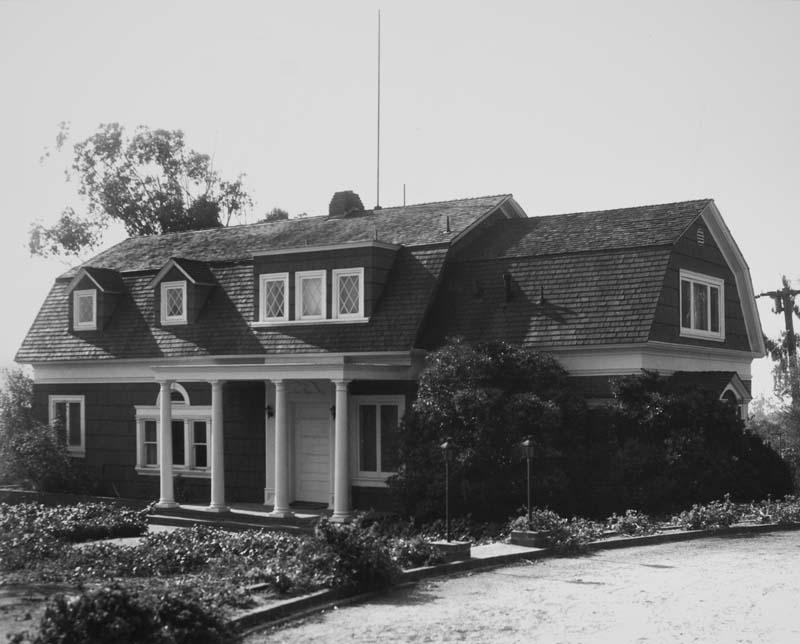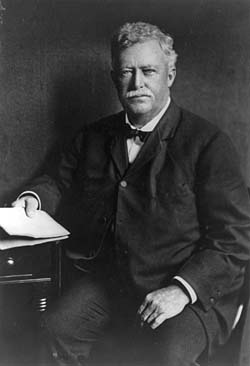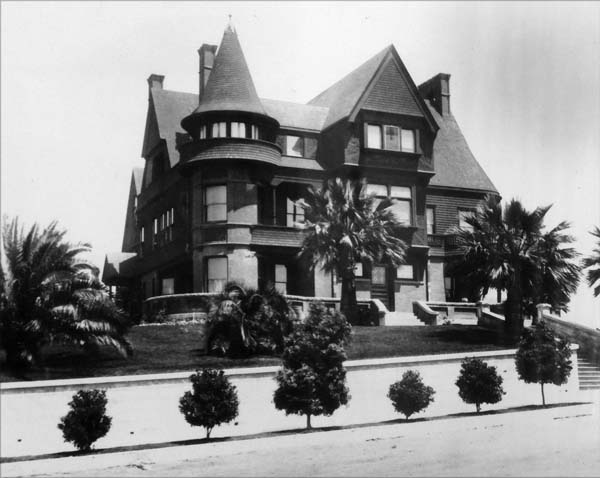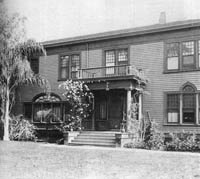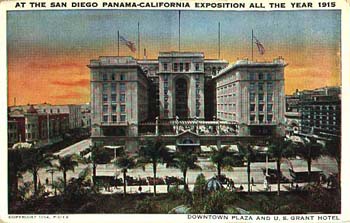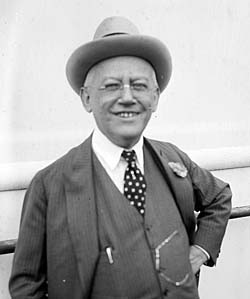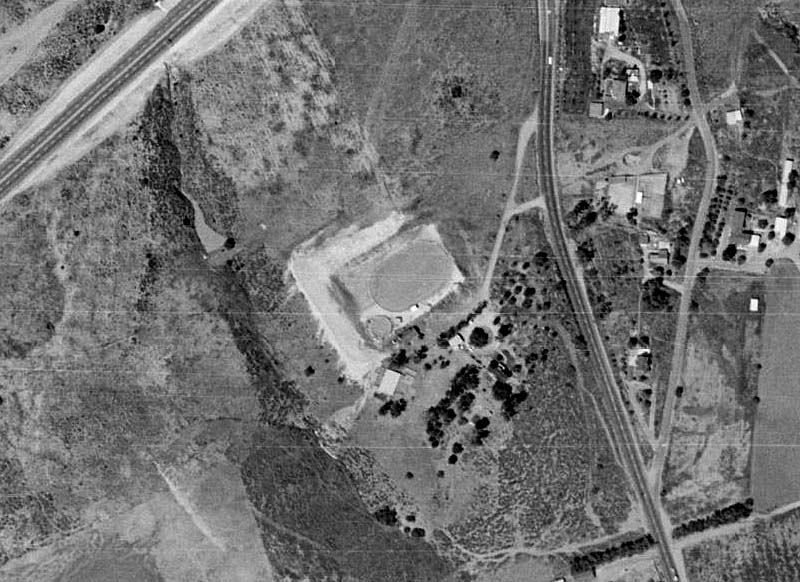|
Grant House
The Ulysses S. Grant, Jr., house was built in 1894 at 5771 Sweetwater Road.
1894 - President U. S. Grant was the first of our traveling presidents. During his terms of office and in his later years he toured many parts of the country. Coming to California, he enjoyed the land so much that he bought a home in Cajon Valley which, unfortunately, burned. The impressions of California's delightful climate, received by his son, Ulysses S. Grant Jr., influenced the return of the young Grant family, who purchased attractive "Queen Ann" style mansion on Prospect Hill, corner of 7th and Ash street in San Diego. The price paid for the house was $25,000 though Mr. Havermale who built it, had put $100,000 in house and furnishings but it was getting towards the 1893 depression days and money was hard to get. The site was considered one of the most valuable in the City of San Diego. The beautiful home was dismantled to make way for the El Cortez Hotel. During the time the Grants lived in the house a neighbor, Dr. Arndt who had a ranch in Sweetwater Valley, often took the family for a ride when he come out to supervise the work done on his place. A family such as the Grants, who had been in the public eye for so long must have yearned for some seclusion and so it was that on Jan. 24, 1894, the National City Record announced the presence of Mrs. General Ulysses S. Grant, her son and family, who were purchasing land in the Sweetwater Valley next to the W. W. Whitney Ranch and intended to build a handsome cottage. The lumber for the house was shipped out by the Russ Lumber Co. via the "National City and Otay Railroad" which ran along the foot of the hill near their land. Go out 8th street on the Paradise Valley road until it joins the Sweetwater Road. About a mile or so, to the south and on the right, you will see the house. It is Dutch Colonial style, with a gambrel roof and as modern in appearance as any present day dwelling of its type. You can't miss it. The house has had good care. The Grants sold to Messrs. Laemmle, Van Rankle and Levi of the Universal Studios in Hollywood. They used it as a suburban retreat. The firm sold to G. Louis Farrington, a Convair worker for 19 years who has remodeled the place into a modern home for his wife and 2 attractive little daughters. A brick addition has been built and harmonzing shingles cover the original redwood siding. The generous sized living room (parlor, in 1894) has large picture windows that have the unusual view of the Sweetwater Dam which looks like a tiny model in the distance. Some of the original furniture remains in the house. A love seat, with tapestry covering, is in perfect condition. The first kitchen is now the dining room and a modern kitchen is in the new brick addition. Mrs. Grant's cherry bedroom suit is in an upper room. The bed has the high headboard which was characteristic of the 90's. The dainty carving at the top is used as a motif on the other pieces of the set. On the hillside is the caretaker's house and across the road there had been a small station on the "Otay" railroad. Both house and station was named, "Aloha" by the Grants. In the rear is the original aviary. Landscaping is under way. In front is an unusually attractive eucalyptus tree, tall and straight with its bouquet of foliage high in the air. Bertha (Rhodes) Dyer, who spent her girlhood in Sweetwater Valley wrote me, "Gen. U. S. Grant's son and family lived in that Dutch-style house on the hill opposite Sweetwater Dam during the time we were school children in Bonita. We used to feel sorry for the children when they rode their little burro past the school and looked wistfully while we were playing at recess. They had a private school, with a tutor, in their house." That Bonita schoolhouse was further east than the present school. The U. S. Grant Hotel, in San Diego, built by U. S. Grant Jr., is located on land where the Horton House once stood. On January 1, 1870, Alonza Horton began the trench for the foundation for his hotel. In 1905 when it was torn down to make way for the new hotel the first bricks removed were taken out by Mr. Horton, W. W. Bowers and E. W. Morse who had layed the cornerstone of the Horton House in 1870. The two artesian wells of the Horton House were considered the best water In San Diego. Today, capped, they remain in the basement of the Grant Hotel. One of them is used for grounding the radio station in the building. ("In Old National City" By Irene Phillips, Chula Vista Star-News, July 17, 1958)
He was probably the most prominent but the least remembered of San Diego men of the late nineteenth century. His quiet manner, his easy acceptance of the differences of opinion, and his continuing ties with New York and the East, all gave him an air of aloofness. His many friends liked him but few really understood him. Ulysses Simpson Grant, Jr., the son of the eighteenth President of the United States, did much to promote San Diego the world over. Along with Alonzo E. Horton, the founder of New Town, he became one of the outstanding businessmen in Southern California. Born in Bethel, Ohio, July 22, 1852, Ulysses S. Grant, Jr., nicknamed Buck by his family, was the second son of Julia Dent and Captain Ulysses Simpson Grant. When his father became President in 1869, Ulysses, Jr. attended Emerson Institute in Washington for two years and then was sent to Phillips Exeter Academy in New Hampshire to prepare for Harvard. After his graduation from Harvard University in 1874, he chose to enter the legal profession and two years later graduated from the Law School of Columbia University in New York City. Admitted to the New York bar, he entered the law firm of Elkins as a junior member. Unlike his father, Ulysses, Jr. never completely yielded to the lure of politics, but he did serve for eighteen months at his mother's urging as private secretary to his father in the White House. The following year he accepted the post of assistant United States attorney for the Southern district of New York during Stewart L. Woodford's administration as governor. At the age of twenty-eight on November 1, 1880, Ulysses, Jr. married Fannie Josephine Chaffee, the only child of Senator Jerome B. Chaffee of Colorado, a wealthy businessman, who had made a fortune in the Leadville mining boom. They were married in the home he had purchased at 26 58th Street, New York City. They had three children: Miriam, born September 26, 1881; Chaffee, born in the "Berkshire," September 28, 1883; and Julia, born at the "St. Cloud Hotel," April 15, 1885. (Banning, 1981) 1893 - The Reid Brothers of Hotel del Coronado fame designed the home for Oren S. Hubble in 1887, who sold the property within two years to an unknown buyer. In 1893, the founder of National City, Ralph Granger, purchased the property. Two months later, Fannie C. Grant, daughter-in-law of former president Ulysses S. Grant, purchased the land and home. From there, she and her husband, U. S. Grant, Jr., could watch construction of their namesake hotel (the US Grant) underway in San Diego's downtown on Broadway. In 1926, the U.S. Grant Company sold the property to the Southern Trust and Commerce Bank. Richard R. Robinson, Jr. acquired the property from the bank shortly thereafter and tore down the Reid-designed home to make room for the El Cortez. ( Ciani, 2000 )
Hubble-Grant house in San Diego built 1887 on Prospect Hill where later the El Cortez Hotel would be built.
1894 - William Sterling Hebbard graduated from the Cornell University School of Architecture in 1887. He came to San Diego near the end of the 1880s boom decade and designed the power plant for the San Diego Cable Company. In 1891, Hebbard became an associate with the Reid Brothers and took over their firm when the
1894 - The U. S. Grant, Jr. house at 5771 Sweetwater Road is a Dutch Colonial Revival two-storied structure with gambrel roof and gabled dormer windows features shingles over the original redwood siding and bricks placed over the cobblestone foundation. The four Ionic columns which support the southeast facing entryway have been moved from the west facing facade which was originally an open porch. The porch entrance has been enclosed. Decorative and plain, fixed and casement, windows complement the residence. Mature eucalyptus, pine and Moreton Bay chestnut trees provide shade behind the northwest facing facade. A modified carriage/ garage structure rests on the northeast portion of the property. This rare Dutch Colonial Revival style residence, built for Ulysses S. Grant Jr. and his family on a five acre tract in 1894 is one of the few remaining 19th century structures in the Sweetwater Valley area. Located on a knoll overlooking the Sweetwater Lake and dam, the cottage, designed by noted San Diego architect, Will Sterling Hebbard, cost $1800 to build. Called the Aloha Ranch, the son of the president owned this property until 1925. Grant, a graduate of Harvard and Columbia Universities, became a lawyer by profession. He married Fannie Chaffee in 1880, the only child of Senator Jerome Chaffee of Colorado. In the fall of 1893, the Grants moved to San Diego in hopes that the mild climate would improve Fannie's health. U.S. Grant Jr. practiced law in San Diego as well as serving on the Park Improvement Committee with George Marston and others. and was the chairman of the Board of Directors for the 1915 Panama-Califomia Exposition. In 1926, Max Rabinowitz, a pioneer San Diego grocer, and his wife Mollie, purchased this property. Carl Laemmle, associated with Universal Studios in Hollywood, bought this tract in 1931 for use as a suburban retreat. In 1945, G. Louis Farrington, a Convair executive and his wife, Mary Olson Farrington, who spent her early years on the Olson Bonita ranch, procured this residence and acreage and continued to reside here through 1990. (Carrico, 1990) 1894 - The U. S. Grant, Jr., Caretaker's Cottage is a two-story clapboard Colonial Revival structure most likely built in 1894 as a caretaker's cottage associated with the U.S. Grant Jr. estate just to the northeast of this property and across Sweetwater Road. A composition gable roof has a dormer projection centered on the east facade over the front entrance, which also has a gabled roof. Regular spaced double hung windows arc placed symmetrically around the facade and flanked by painted shutters. A small wooden rail fence and stone wall accent the mature landscaping. This frame caretaker's cottage, associated originally with the Ulysses S. Grant, Jr. property, housed employees of that family from 1894. Anna Held, governess to the Grant children, companion and attendant to Fannie Grant, and founder of the Green Dragon Colony in La Jolla, most likely resided here while the family was in residence. As the Grant children did not attend school but were tutored privately, their teachers probably lived here with their school facilities located somewhere within this structure. G. Louis Farrington and his wife Mary, who bought the Grant property in 1945, moved this structure in 1948 to 5761 Quarry Road and remodeled it as a single family residence. Used as a rental until 1968, it was purchased that year by Norman and Jerilynn Palmer. (Carrico, 1990) 1895/01/01 - U. S. Grant, Jr., is firmly convinced that the city offers a fine field for investment. He has shown his faith by purchasing two of the finest building sites in the city, one 100x100 on Fifth street, just north of D, and the other of the same size at the southeast corner of Sixth and D streets. Plans have been made for the building to be erected on the former site. It will be a three-story modern brick and stone structure, ornately finished outside, and of commodious proportions, costing $30,000. The basement has already been dug for this building and the foundation will be commenced at once. The building at Sixth and D streets, if present plans are carried out, will cost $15,000. but Mr. Grant may decide to add another story, making three, which will raise the total cost. It is possible that the Y. M. C. A. will accept Mr. Grant's offer of the entire second floor of the new building designed expressly for the uses of the association, for $1,000 per year. The lower floor of the building will be devoted to stores. Mr. Grant has also purchased a country home in the Sweetwater valley, a short distance this side of Sweetwater dam, consisting of seven acres, upon which he is building a cosy cottage to cost $2,000 or $3,000. The grounds will be planted to all kinds of fruits, and in a short time will be one of the most attractive country places in the suburbs of the city. ( San Diego Union, Jan. 1, 1895)
1913 - Four years after his wife's death, Grant, Jr. remarried on July 12, 1913. His second wife was a young widow, active in the social life of San Diego. Grant, Jr. and America spent six years traveling and in the early 1920s made their home in the nation's capital. On their return to San Diego in 1925, Grant, Jr. sold the mansion on Prospect Hill to Dick Robinson and Associates and saw it torn down to be replaced by the El Cortez Hotel in 1927. The Grants then took up residence in the U.S. Grant Hotel and there in their luxurious rooms entertained many nationally prominent figures. They continued to travel, however, mainly in California. In 1929 they took a four-month auto trip with America's nephew Sidney Halbert. While on their way home, some 270 miles north of San Diego, Grant, Jr. became so ill that they made an early stop on the Ridge Route at Sandberg Lodge. During the night of September 26, U.S. Grant, Jr., one of the pioneers and early builders of San Diego, died at the age of seventy-seven. (Banning, 1981)
1931 - Carl Laemmle, the founder of the Universal Film Company in Hollywood, bought the Grant house and surrounding property in 1931 for use as a suburban retreat. ("In Old National City" By Irene Phillips, Chula Vista Star-News, Jul 17, 1958) 1937/01/02 - This sales offer appeared in the Los Angeles Times in 1937, two years before the death of Carl Laemmle: "San Diego offer 128 Acres, part of the U. S. Grant Estate, owned now by Carl Laemmle and associates. Close to Sweetwater with a wonderful view. Modern home of 5 rooms, caretaker's house, fine shade and shrubs, family fruit, plenty water, chicken equipment and the Ideal spot and acreage for Gentleman's Country Estate, Can be made very productive also. Will consider exchange in or near Los Angeles, prefer close-in Country. Submit, J. W. Pearce And Associates 411 West 5th St." ( The Los Angeles Times, Jan 2, 1937 ) 1945 - Louis Farrington bought the Grant house in 1945. George Louis Farrington, a philanthropist and lifetime resident of the area, died last Sunday in a local hospital after a short illness. He was 89. Mr. Farrington is one of those rarities that we find in the South Bay. He spent nearly his entire life as a Californian. He was born in a small town in Colorado Dec. 1, 1911, but his parents almost immediately moved to San Diego before he was 1 year old. Though he never said so, he was probably one of the original surfers. Mr. Farrington grew up in Ocean Beach where he enjoyed surfing, swimming and other water-related activities. He also learned to dance at an early age and enjoyed it practically all his life. Mr. Farrington quit school at the age of 16 to help support his family. He had various menial jobs that included a stint with the WPA, but then went to work in aviation, first at Ryan Aeronautical Company and then at Convair. Mr. Farrington always had the acting bug. While working with a theater group in 1937 he met Mary Elizabeth Olson, a Bonitan, who was to become his wife, a union that lasted for 54 years. In 1945 they bought 130 acres and the structure that is known as the U.S. Grant house. It was originally owned by U.S. Grant Jr., who also owned the U.S. Grant Hotel in San Diego. For many years the house was the hub of their activities. They had three daughters, Jaimie, Georgia and Lenore, who became animal lovers, particularly horses. Mr. Farrington himself was quite a horseman, raising and training them. Mr. Farrington's wife, Mary, died in 1993. ( Chula Vista Star-News, Mar 11, 2000) 1945 - Louis Farrington and his family lived on Sweetwater Road in the house referred to as the U.S. Grant House. It is the large structure with the pitched roof, clearly visible from the road. It was the summer home of the Grant heirs back around the turn of the century. Farrington lived there until just a few months ago. In our conversation I learned that Farrington was born in 1911 in Saguache, Colo., and when he was a year old, the family relocated to San Diego and settled at Ocean Beach. He grew up there and attended the local schools until, at the age of 16, he quit school to go to work. He started out by working in various odd jobs. He was a filling station attendant, a small truck driver, and worked for an ornamental metal and stone shop. He said that the Agua Caliente Racetrack was being built at that time and his shop supplied much of the ornamental work in the architecture of the building. Like many men of Farrington's age, he also had a stint with the WPA during the early '30s. Finally, however, he went to work for Convair, which in later years became General Dynamics. He was in the tooling department, and quickly worked his way up to shop foreman and remained in that position until he retired in 1968. In those formative years Farrington became interested in the theater. He was in numerous amateur productions and it was through one of these that he met Mary Elizabeth Olson, a young lady who lived with her parents in Bonita. They married in 1939 and had three daughters, Jaimie, Georgia and Lenore. Over the years the Farringtons were very involved in community affairs. Their principle love was music and the theater. They belonged to many musical groups in the area, including the San Diego Opera and the San Diego Symphony. The family also invested in various real estate ventures that proved profitable and allowed Farrington to retire early. Mary died in 1993. Sometime later Farrington moved out of the large house on Sweetwater Road to the retirement of Fredericka. We may wonder what he might do in retirement. He told me he has recently enrolled in a ballroom dancing class and attends dances two or three times a week. While listening to him recite his story, I sort of thought of Horatio Alger character. George Louis Farrington fits the mold. (Around the South Bay by Richard Pena, Chula Vista Star-News, Feb 8, 1997)
This 1964 aerial photograph shows the large oval equestrian ring on the Grant house property used by the Westwind Riders.
1961 - The Westwind Riders began as a riding club of youngsters who met at the Farrington Farm the first Saturday of each month. In 1962, eleven members of the club received awards, and the club itself received a flag that has flown over the nation's capitol, at the group's first annual awards and installation dinner this week. The flag was presented by Richard Wilson in behalf of his brother Rep. Bob Wilson, who obtained the flag. Leo Reed, president of the County Horse Assn., installed Barbara Torkildson as president; Katie Perry, first vice president; Dana Pakke, second vice president; Paula Farrington, recording secretary; Pam Sharp, corresponding secretary; Susan Crouch, treasurer; and Georgia Farrington, publicity chairman. The riding club had a closed show for members only once each month and an open show each year, generally in June. (Chula Vista Star-News, Jan 4, 1962) 1970/11/08 - "Danger at the Farm," produced by DeBello Productions, Inc., will long be remembered as one of the great classic dramas of our time. It was certainly a fun movie to make, but Steve Gurnsey, Dorothy Mayer and Cindy Charles are wondering if they'll be suspended after Mr. Noe sees it. By the way, the film made just enough profit to post John DeBello's bail. There will be one more showing tonight at Farrington Farm, but watch out, there are rumors of a police raid! (by Steve Brault in Chula Vista Star-News, Nov 8, 1970) 1970/11/15 - Movie making isn't easy, Bonita Vista High School writer, director, producer and cameraman John DeBelio will readily testify. Responsible for most of the work on the recently completed "Danger at the Farm," he said work on it stretched over six months and out of necessity he became adept at handling numerous actors, camera store clerks, funny looks from upstanding citizens, dozens and dozens of film splices, as well as Chula Vista police. He wrote the entire script for the movie, which lasts an hour, and was also responsible for much of the casting and production ol the film. "The hardest problem was getting everyone together at the right lime, especially the Indians No one seems to notice, but there is a different tribe of Indians in almost every scene." It took all summer to gel the people together enough times to shoot the movie, and in Ihe final version dialogue scenes, shot months apart, are spliced togelher and appear to be happening at the same time. John's casting efforts also included putting together a group of hippies for a riot scene at Doctor's Park, at 4th and F in Chula Vista. Neighbors, seeing the filming of portions which included the attacking of a car driving into the parking lot. directed pobce toward the amateur movie makers. "I was the one who had to handle them," said Steve Peace, ASB president at Bonlta Vista and an actor in the movie. "The policeman was ready to believe we weren't attacking good members of the community," Steve recalled. "Only after he saw the camera did he change his mind, and even then he kept a close eye on all of us." Memories of Ihe incident still linger on in the police department, Steve said. "A couple of months later the same cop stopped me at night for suspicion ol burglary because I made a U-turn with my headlights out, " he said. "And he recognized me as the one that started the riot in Doctor's Park." Contacts with the local citizenry also came about during filming of sequences in which Marie Orrentia, one of the heroines, was bound hand and foot and left on a railroad track awaiting the train. "We shot that at the tracks down by Rohr about 40 feet from the street. You just wouldn't believe the looks we got from people passing by." Dennis Poulos and Gary Jacquot, two national guardsmen in the movie, also came in for their share of gazes as they were filmed trying to hitchhike, in full combat uniform Including helmets, can-teens and rifles, along Otay Lakes Road. And John had his share of funny looks from camera store clerks as he bought 400 film splices. He also had some problems getting his actors to do what they were supposed to do in the movie, although he says there weren't too many difficulties. In classic movie form, they often had to have several retakes of each scene. Unlike classic movie form, however, "Danger at the Farm'' shows at the end of Ihe movie many of the mistakes conventionally left on the cutting room floor. "Most of the people were pretty good," John said, "but Marie was always laughing and John Miller, the Indian chief, was too much of a ham. Marie did an outstanding job in the movie, though, and so did John. He has a terrific amount of acting talent." DeBello wrote the entire movie himself, a process which took a month, he said. Baron moviegoers say that the type-casting in the movie is almost perfect, and John admits that he "had certain people in mind" when he created certain roles. He also shot the entire movie himself. "We would have liked to film from more than one angle during each scene," he said, "but we only had one camera. Sometimes we ran the scene three or four times and used the best film." Editing the three-reel film took about 25 hours, he said. Compounding normal editing problems was the fact the scenes of the movie were spread out over the 13 film spools he used. John still has a bushel basket full of unused film. The total cost of the movie was over $160, of which some $130 went to film and the rest to costumes, props and other materials. John said he didn't have definite plans for another movie now, but won't rule out the possibility. "It takes a lot of time to put the plot together," he said, "and it could never be shot when school is in session." (Chula Vista Star-News, Nov 15, 1970) 1970/11/15 - Barons producer John DeBello wrote, directed and produced "Danger at the Farm," an hour long, full color, action-packed movie with a cast of some 60 Bonita Vista students and a Chula Vista policeman, is virtually guaranteed to warm the hearts and split the sides of nearly anyone who sees it. The creation of Baron senior John DeBello, it took nearly all summer to make and was shot on location throughout Chula Vista. But New York's legendary Boss Tweed would feel right at home during parts of it. So would harried National guardsmen, demonstrating hippies, evil dobadders, Mafia chieftains and cynical Indian savages. Anyone else should come to the movie prepared to do a lot of laughing. It was shot at several spots throughout Chula Vista, but most of the action centers around the Farnsworth Farm, in real life the Farrington Farm in Bonita. Unlike most home movies, the plot is complex and the acting, especially that of co-star Lenore Farrington and Indian chief, John Miller, is outstanding. The film is silent, but short written scripts clarify the dialogue between characters. The cast, including extras, includes more than 60 persons, with 19 major characters, DeBello said, and the movie even includes a shot of the Chula Vista police, who came to bust them for staging a riot-scene in a parking lot. The movie centers around the efforts of several groups competing to gain control of the Farnsworth Farm, inhabited only by two helpless female farmers. Leading one charge on the farm is Indian chief Bull Sit, an Indian head who has his problems. Neither can he shoot an arrow nor are any of his track-shoe-shod braves equipped with matches to burn a captive at the stake. They can't even start a fire by rubbing two sticks together, despite instructions from the YMCA Indian guide. Also after the farm is evil Bruce Whitmore of the State Highway Commission, who wants to turn it into a freeway. The girls won't sell, so he tries to arrange an accidental fire, with napalm. But no napalm is to be had because POW! Chemicals, the producers, have been under attack by militant hippies for the past two years. Whitman and his inept assistant escape from the plant, carrying an autographed picture of Ronald Reagan given to them by the POW! Chemical leader, just before the hippies invade and destroy the last strongholds of the flag-toting scientists in the napalm plant. A rich movie actress wants the farm so she can reap publicity from fighting the highway department, and dispatches her business manager to buy it for her. But despite strong temptations brought on by endless piles of crisp green money, the girls refuse. Also after the farm is the Mafia, personified by two triggermen, Cosa and Nostra. Allied with the homesteading girls, however, is the California National Guard and DOG, a group of noticeably braless, cigar chomping women dedicated to the "Deliverance of Girls." But only two members of the National Guard are available, the rest having been shipped to the front at UCLA. But although the DOGS show their nonchalance toward a pep talk by head DOG Norma by blowing smoke rings, enough of her snarling, cigar-chewing Boss Tweed style sinks in to enable the DOGS to beat up the Indian tribe in the end. Cosa and Nostra fall victim to the FBI at the conclusion of the movie, and the two national guardsmen, their vehicles taken, end a long journey by foot and hitchhiking to the farm in time to surprise the DOGS just before they destroy the Indian tribe. The original farm girls, driven to desperation, then find Whitmore and offer to sign, only to find the highway has been rerouted and the state won't give them any money. Frantic, they simply run as far and as fast as they can from their formerly beloved farm. "Danger at the Farm" is being shown at the farm, the Farrington Farm, near the intersection of the Sweetwater Rd. and Quarry Rd. tonight at 7:30. Admission is 50 cents for students, and the parking concessionaire will nick you for another nickel. Profits from the movie will go to a yet-to-be-determined "worthy cause," according to DeBello. (Chula Vista Star-News, Nov 15, 1970) 1971/02/14 - Zanuck probably envies Bonita Vista filmmaker. Bonita Vista film producer John DeBello doesn't make three-hour movies on multi-million dollar budgets, but he does do something a lot of Hollywood moviemakers would like to do. He has turned a profit on his last movie, called "Danger at the Farm," it has earned about $120 in profits in five public showings. Total revenues are about $300. DeBello reports, and the total cost of the movie was about $180. He showed it four times at the Bonita home of Lenore Farrington, the site winch doubled as the setting for much of the movie. Also, the 45-minute color film was shown In three installments during lunch at Bonita Vista. Students at Hilltop High have expressed an interest in seeing the movie, he added. Students had to pay 50c to see it at the Farrington home and 15c for each lunchtime showing. Adults had to pay a dollar. At the Farrington's, popcorn was also sold. The movie, made last summer, was directed, filmed and produced by DeBello, and featured a cast drawn from the students of Bonita Vista. It took most oi the summer to write, film and edh, DeBello said, and has a cast of about 40 people. (Chula Vista Star-News, Feb 14, 1971) 1978 - On the trail of Killer Tomatoes released in 1978. The lobby of Four Square Productions over in Kearney Mesa has one of those well-appointed, yet simple decors found in many new buildings. Occupied only since May, it still has a newness about it, a breaking in, so to speak, with people accustomed to their surroundings. It looks, in fact, like any other new lobby until one sees the three large, theater posters encased in glass adorning one of the walls. "Attack of the Killer Tomatoes," says the first, followed by "Return of the Killer Tomatoes," and "The Killer Tomatoes Strike Back." Now the lobby has taken on a singular personality and one to which we can relate. I was in the building the other day to talk to the president of the company, John Debello, a pleasant young man who has lived in Bonita all his life. He is a product of Bonita Vista High School, a senior class president in fact, who was in the graduating class of 1971, one of the first at the school. Those were the days when a 33-30 loss to Sweetwater was considered a moral victory for the fledging school and the football season was declared a success. In the ensuing years Debello has made his mark in business. He not only started the business he is in, but in a sense, invented it. In all fairness Debello was not alone in this enterprise. One of his classmates, in those years was our present Sen. Steve Peace, a young man interested in school government then and state government today. According to Debello, when they were in 11th grade they put their first Tomatoes' feature film together, an "adventure saga" shot at Farrington Farms, the site of the U. S. Grant house on Sweetwater Road. The story line of that first film is, no doubt, lost in antiquity but it probably was the forerunner for those "Killer Tomato" films that came along in the late 1970s and 80s. The 'Killer Tomatoes' have, over the years, become icons of the industry. They have acquired a status of 'cult films' that means, simply, that they have a following that will stay with them forever. They are comparable to such television fare as 'Gilligan's Island' or 'Green Acres' that because of that following have become classics. Although productions such as the Tomatoes' and others are tangibles. Four Square Productions is a serious, complex communications firm. Over the years they have searched for and acquired some of the best technology in the business From a handheld camcorder to the latest the many solutions to industry. At the present Four Square is in two divisions. The communication group produces major live event presentations and other type of training projects to firms nationwide. The entertainment group provides outstanding motion picture and television programming to audiences worldwide Debello still lives in Bonita not far from the house of his mother, Irene, where be was raised with two brothers, one a U.S. Airforce musician and the other a businessman Debello has the satisfaction of having seen a business, molded from scratch developed into a one-of-a-kind entity. Not bad for the once class president from Bonita Vista High School. (Around the South Bay by Richard Pena, Chula Vista Star-News, Aug 15, 1998 ) SOURCES:
|
|||||||
|
Home •
About Us •
Next Meeting •
Latest News •
Resources •
Organizations •
Exhibits •
Bulletins
Contact
|
|||||||
|
This web page was created May 13, 2017, and revised May 17, 2017, by Steve Schoenherr for the South Bay Historical Society | Copyright © 2017
|
